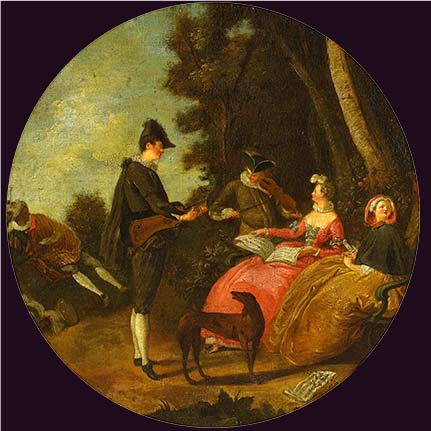
- Home Page
- Accepted
Paintings & Copies - Doubtful
Attributions - Doubtful Textual References
- Alternative
Titles - Collectors &
Museums - Bibliography
- Search Abecedario
- Watteau &
His Circle
X. La Sérénade
Entered July 2021
Whereabouts unknown
Oil on canvas
90 x 90 cm
PROVENANCE
Paris, sale, Hôtel Drouot, March 15, 2017, lot 115: “Antoine WATTEAU . . . , école de / La Sérénade / Huile sur toile de forme rectangulaire. (Manques, quelques restorations, notamment dans les coins, ancien vernis oxydé). H. 90 L. 90 cm / Cadre en bois et stuc dorés à motif de coquilles avec une ouverture centrale de forme ronde (Diam.: 87 cm) / 2 000/3 000€. Le guitariste debout se retrouve dans des compositions d’Antoine Watteau: La Leçon d’amour (Toile, 44 x 61) du musée de Stockholm et L’Enchanteur (Bois, 18,5 x 25,5 cm) du musée de Troyes (Cf. Catalogue de l’exposition du Musée Jacquemart-André, de Watteau à Fragonard, les fêtes galantes, no 6, pp. 50-51, 2014)."
REMARKS
As has been noted, the guitarist is based on an invention that Watteau used twice in his paintings: in L’Enchanteur, now in Troyes, and La Leçon d’amour, in Stockholm. Although the woman at the right—a vocalist with a part book in her lap—bears a resemblance to Lancret’s work, a more concrete link cannot be found. Moreover, the style of these figures is unlike that of the early eighteenth century. These characters are taller, less solid, and have remarkably small heads. All this points to a date closer to at least the middle portion of the eighteenth century.
The circular format of the composition raises similar issues. The picture is painted on a rectangular canvas, but what is in the corners? Are they blank or do they contain additional landscape to fill out the rectangular field? Whereas ovals are a common and popular format for early eighteenth-century paintings, circular works are rare until the second half of the century. In short, is this an indication of when the painting was created or is this a problem of conservation?
